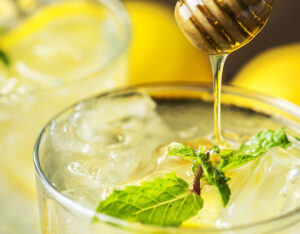WHAT TO DRINK?

Some health professionals and health activists like to ignore this simple fact – people love to drink Calories, not just water, and have been doing so since the dawn of Homo sapiens. One of our first experiences outside the womb, our first drink, is (hopefully) human milk, the sweetest of all mammalian milks, with ~7% lactose. But there’s more liquid enjoyment to come – fruit juices, flavoured milks, soft drinks, hot chocolate, and eventually wine, beer, spirits, cocktails, not to mention coffee, tea, and herbal concoctions that are usually less energy-dense (but not always!).
In fact, on average, people in western countries currently consume about 10% of their total energy intake in liquid form (1). That’s a large chunk that we like to ignore. The Australian Dietary Guidelines essentially state that water is the best drink, even for children, while sugar-sweetened beverages can be occasional treats. On the other hand, Australia’s National Health and Medical Research Council have recently revised guidelines on alcohol intake for adults – not more than 10 standard drinks a week (equivalent to 100 grams of pure alcohol) and no more than 4 (40 grams of pure alcohol) on any given day (2). That’s still very generous compared with our guidelines for soft drinks!
Barry Popkin and colleagues (3) take the view that humans lack a physiological basis for metabolising Calories in alcoholic and soft drinks because only breast milk and water were available for the vast majority of our evolutionary history. They claim that alternatives appeared in the human diet only 11,000 years ago and postulate that carbohydrates in water and alcohol bypass satiety mechanisms, thereby encouraging weight gain.
I’m not a fan of their hypothesis. First up, from a physiological perspective, babies know when they are hungry and when they are full, drinking only breast milk or formula for the first few months of life. The vast majority grow perfectly well along their genetically determined percentile. Secondly, when we crunch down on that crisp apple, we are applying with our teeth and jaws enough pressure to squeeze the sugary juice out of plant cells and into the mouth, swallowing a roughly 50:50 mixture of liquid and solids. The liquid fraction contains about 10% sugars in solution…coincidentally, the same as in a typical soft drink. Thirdly, one of the fastest and effective ways to lose weight is using total meal replacement “shakes” (i.e., Very Low Energy Diet formulas), a completely liquid diet, in which around half the Calories come from sugars. Most people that use total meal replacement “shakes” don’t feel excessively hungry.
Anthropologists have studied the diets of modern-day hunter-gatherers. Karen Hawkes and colleagues documented that the Aché people in the jungles of eastern Paraguay collected at least 14 kinds on honey (a viscous liquid) in large amounts (up to 25 kg (55 pounds) a day), using axes and smoke. Both sexes typically go honey hunting. When found, they ate their fill on the spot, but often took some back to camp to be made into a sweet drink by mixing with water, i.e., the first soft drinks. In the Aché diet, oranges contributed the most energy from plants (290 Calories (1,215 kJ’s)/consumer/day) and honey (109 Calories (455 kJ’s)/consumer/day) came in second.
What are the chances that somewhere in the warm tropical jungles of planet Earth this sweet mixture would begin to ferment quickly, that the bubbly liquid tasted very pleasant (the first mead) and had interesting psychotropic effects (!) that encouraged deliberate attempts at further production? When and wherever fruit fell from the tree and the rain fell, the mixture fermented. One day, an enterprising individual stomped grapes and made the first wine.
The anthropological literature of Australia’s indigenous people tells us that water was often sweetened with flower nectars, although as far as we know, they did not make alcoholic beverages. In Ancient Rome, wines were sweetened with honey, and in medieval Britain, monks practiced apiculture, and made large volumes of mead to feed to the masses on Sundays. Indeed, they extinguished fires with mead, not water, since it was available in greater volume. Once rivers and streams became fouled by sewage, mead and other alcoholic beverages were safter to drink than water. You can read more about the history of honey in the diet in our research paper published in the British Journal of Nutrition in 1996 (4).
It was not until the early 1700’s that the supply of sugar boomed, its price fell, and coffee, tea and chocolate entered the British diet. Today, it is not unusual to drink 6 cups of coffee or tea a day. Indeed, my husband often drinks 6 coffees, and my grandmother drank up to 12 cups of tea, all of them sweetened. She died in 1998, at the ripe old age of 106.
The health effects of coffee have been given close scrutiny in recent years. Caffeine, chlorogenic acids and diterpenes are important components of coffee. Although, tolerance often develops over time, there is a significant impact on the cardiovascular system, and on carbohydrate and lipid metabolism (5). Contrary to previous beliefs, arrhythmia or heart insufficiency seem unaffected by coffee intake. On average, observational studies find higher coffee intake is associated with a 30% reduced risk of type 2 diabetes (6). There may also be reduction in risk of developing liver disease, Parkinson’s disease and osteoporosis. Our team at the University of Sydney found that neither coffee nor tea had effects on postprandial (after meal) glucose responses, although interestingly, sweetened coffee consumed 1 hour before a meal reduces the glycemic effect of the meal (7).
Milk drinking is associated with higher bone density in children (3), an effect related to its high content of calcium, phosphorus and other minerals that go into making and maintaining bone. Milk substitutes such as soy and rice milks may not provide this benefit. And recent research suggests that even full cream milk is not associated with increased cardiovascular risk (8).
In my view, we need to admit that sweet beverages have always played – and always will play – a central role in human diets. Yes, some may be more healthful than others, but water is not the only option and not the one we prefer for all occasions. We must weigh up the fact that alcoholic beverages have immense economic and social value, yet significant adverse effects far beyond their Calorie content, including cancer, foetal alcohol syndrome, road accidents and domestic violence. When we disparage and demonise soft drinks and fruit juice, but tacitly sanction alcoholic beverages (up to 4 standard drinks on any one day), the unintended consequences may not be as inconsequential as some imagine.
Read more:
- Sui and colleagues. Discretionary food and beverage consumption and its association with demographic characteristics, weight status, and fruit and vegetable intakes in Australian adults. PHN, 2016.
- NHMRC. Australian guidelines to reduce health risks from drinking alcohol. 2020
- Wolf and colleagues. A short history of beverages and how our body treats them. Obes Rev. 2008
- Allsop and Miller. Honey revisited: a reappraisal of honey in pre-industrial diets. Br J Nutr, 1996
- Cano-Marquina and colleagues. The impact of coffee on health, Maturitas, 2013
- Carlström and Larsson. Coffee consumption and reduced risk of developing type 2 diabetes: a systematic review with meta-analysis. Nutr Rev. 2018
- Louie and colleagues. Delayed effects of coffee, tea and sucrose on postprandial glycemia in lean, young, healthy adults. Asia Pac J Clin Nutr. 2008
- Arne Astrup and colleagues. Effects of Full-Fat and Fermented Dairy Products on Cardiometabolic Disease: Food Is More Than the Sum of Its Parts, Advances in Nutrition, 2019
Emeritus professor Jennie Brand-Miller held a Personal Chair in Human Nutrition in the Charles Perkins Centre and the School of Life and Environmental Sciences, at the University of Sydney until she retired in December 2022. She is recognised around the world for her work on carbohydrates and the glycemic index (or GI) of foods, with over 300 scientific publications. Her books about the glycemic index have been bestsellers and made the GI a household word.








